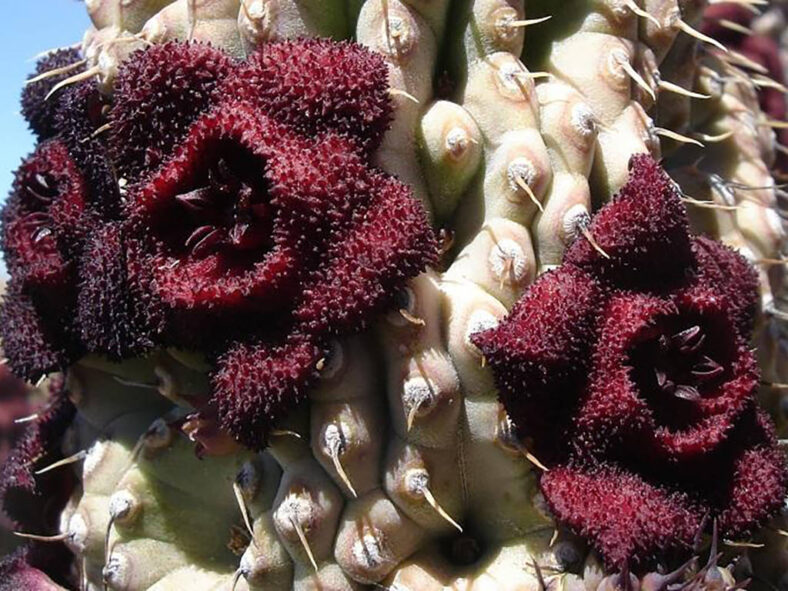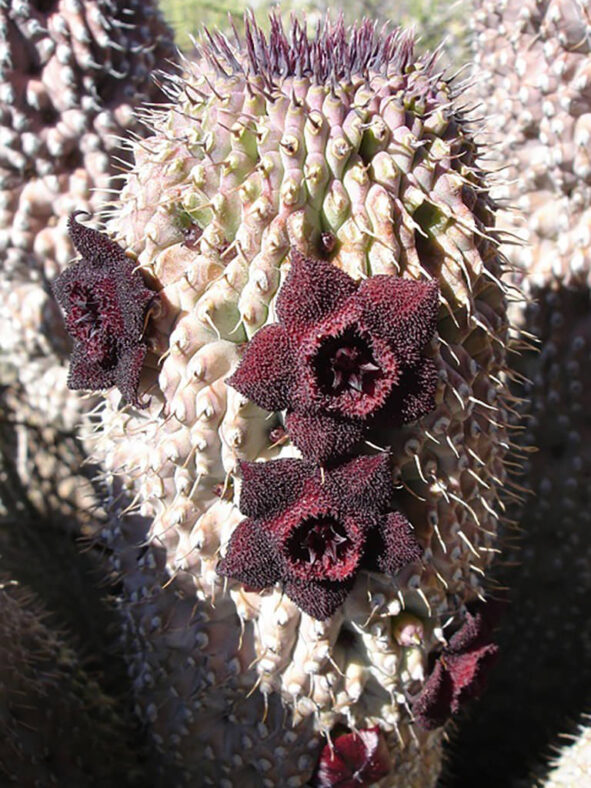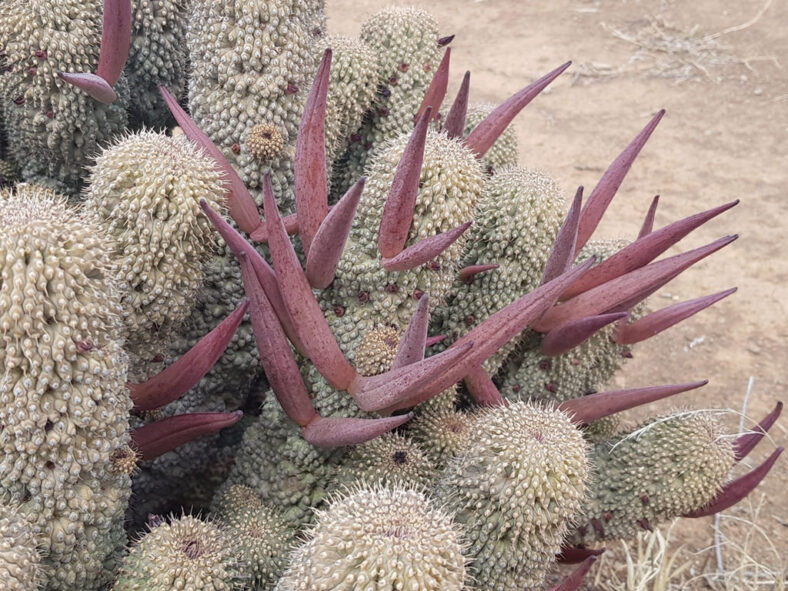Hoodia pilifera subsp. annulata is a cactus-like succulent distinguished by its often very prominent annulus in the corolla. It was first described as Trichocaulon annulatum in 1909.
Scientific Name
Hoodia pilifera subsp. annulata (N.E.Br.) Bruyns
Synonym(s)
Ceropegia pilifera subsp. annulata, Hoodia annulata, Trichocaulon annulatum
Scientific Classification
Family: Apocynaceae
Subfamily: Asclepiadoideae
Tribe: Ceropegieae
Genus: Hoodia
Etymology
The subspecific epithet "annulata" (pronounced "an-yoo-LAH-tuh") means "ringed, fettered" and refers to the raised, ring-like structure (annulus) on the corolla that encloses the corona of this subspecies.
Origin
Hoodia pilifera subsp. annulata is native to South Africa. It grows on flat areas between low hills on slightly gravelly ground, rarely on hill slopes, in the southern Great Karoo, from Aberdeen and Graaff-Reinet southwards to Rietbron and eastwards to Willowmore, Klipplaat, and Steytlerville.
Description
Hoodia pilifera subsp. annulata is a large succulent shrub with upright, cylindrical stems that have tubercles fused below the middle, forming 20 to 23 angles along the stem. The stems, which can grow up to 20 inches (50 cm) tall, typically range in color from dark greyish-green to brown-green. Each tubercle is tipped with a stiff spine that can be grey to brown, measuring up to 0.25 inches (0.6 cm) long.
In early spring, Hoodia pilifera subsp. annulata produces inflorescences, each usually bearing one flower on a short stalk. The flowers can reach a diameter of 1 inch (2.5 cm). The corolla is maroon or reddish-purple with spreading lobes and a prominent pentagonal annulus. Except towards the base of the tube, the corolla is covered with conical, obtuse papillae, each tipped with a spreading bristle. The corona is dark purple and raised on a very short stipe. The fruits are paired follicles that resemble goat horns, containing numerous seeds.

How to Grow and Care for Hoodia pilifera subsp. annulata
Light: Hoodia pilifera subsp. annulata prefers full sun but will benefit from light shade during the hottest summer days. Indoors, place the plant near the brightest window in your home, as it will stretch if it does not receive enough sunlight. Avoid abruptly moving a plant adapted to lower light levels to full sun to prevent sunburn.
Soil: Use a commercial potting soil mix for succulents or prepare your own with a mixture of 50% to 70% mineral grit, such as coarse sand, pumice, or perlite.
Temperature: The plant thrives in warm outdoor environments with low to moderate humidity. It does not like winter cold and should remain fairly dry and warm during its dormancy. Hoodia pilifera subsp. annulata is hardy in USDA Plant Hardiness Zones 10a-11b, which have average annual extreme minimum winter temperatures ranging from 30°F to 50°F (-1.1°C to 10°C).
Watering: It has typical watering needs for a succulent. From spring to fall, during its growing season, water the plant thoroughly and allow the soil to dry between waterings. When it goes dormant in winter, it requires almost no water, typically only once a month.
Fertilizing: Fertilizing is a good idea to keep the plant healthy and thriving. Use a water-soluble fertilizer diluted to half the recommended strength, but only during the growing season.
Repotting: Repot Hoodia pilifera subsp. annulata in spring, just before the start of the growing season. It has shallow roots and does not require a lot of soil to grow. Always pick a container with drainage holes.
Propagation: The best way to propagate this succulent is by stem cuttings. To ensure good rooting, take cuttings during the growing season. The plant is also easy to start from seeds in spring.
Learn more at How to Grow and Care for Stapeliads.
Toxicity of Hoodia pilifera subsp. annulata
Hoodia pilifera subsp. annulata is non-toxic and safe to grow around kids and pets.
Links
- Back to genus Hoodia
- Succupedia: Browse succulents by Scientific Name, Common Name, Genus, Family, USDA Hardiness Zone, Origin, or cacti by Genus
Photo Gallery
Click on a photo to see a larger version.


